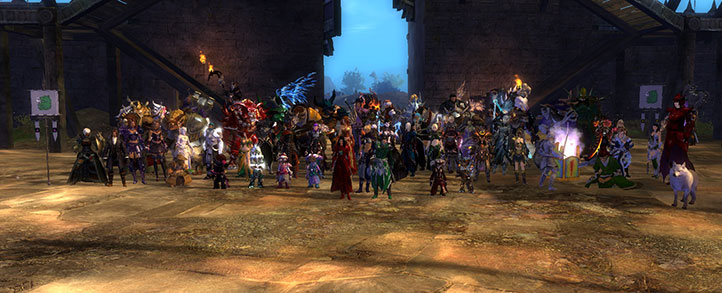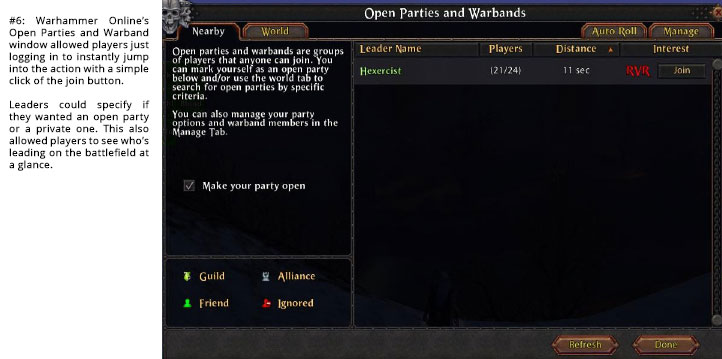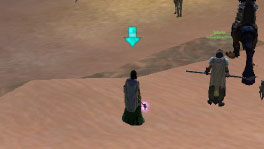10 Most Overlooked MMO Features

I began playing MMORPGs in 2001 with Dark Age of Camelot, and it changed my perspective on MMOs forever. It wasn’t long thereafter that I launched Gaiscioch as a casual social gaming community. Through the years, I’ve seen great MMOs forget the simplest concepts, and hole-in-the-wall MMOs come forth with features that seem so basic and necessary that we wonder how we ever existed without them.
I have come up with 10 things that are absolute essential for legacy communities (5+ years) to thrive in a new title. These are things I constantly share with game developers.
1. Guild Size Restrictions
This is by far the most underestimated base construct of an MMO today. There is no reason to limit guild sizes. I have heard every excuse from “Large communities ruin server communities” to “It causes too much server instability”. Let me put it in the words of Scott Hartsman when I asked him what the guild size limit for RIFT would be: “If you can find one, call me and I’ll raise it.”
For a community that has a five-plus year past, oftentimes reducing the roster to 250 or 500 players is just not possible. As a game developer, you need to ask yourself a question, “Do you want the first experience a player has in your game to be one where they can’t play with their friends?” Quite simply, guilds grow and can snowball over years of gaming together. Players may come and go in any particular game, but they return again in the future to the guild.
A community like Gaiscioch has thousands of members, and any branch is susceptible to a huge surge of players that exceeds the guild cap. In RIFT, Gaiscioch grew to over 2,500 active members in a single month. At the time, RIFT was a pay-to-play game. Financially, Gaiscioch alone was responsible for over $37,475 in subscriptions per month.
Let’s fast forward to the release of Guild Wars 2. Guild Wars 2 limited guilds to 500 players. At launch, Gaiscioch had 5 guilds nearly full and a total of 2,000 players actively playing. The inability to communicate between the guilds and play with their friends resulted in players leaving Guild Wars 2 in droves. Today, we sit at almost 500 active members.
That might have been a fluke, right? Let’s take a look at Elder Scrolls Online. This time, we launched with 1,300 players and were forced into 500 player guilds. We created three guilds, which we call rooms, for long term membership. We had to create two additional short term rooms for the most active players. This room required players to check in on the website every 14 days. Again, the inability to communicate with their friends has lead to players leaving in mass. Our player numbers have dropped from 1,300 to less than 500 in only 4 months.
Each time we’ve launched into a game with a restricted guild system, it’s like launching a potato from a cannon into a cheese grater. Subscriptions bleed out faster than developers can remedy the situation. A community like Gaiscioch has the potential to bring thousands of players into a game, but oftentimes game mechanics shoot us down before we can even get off the ground killing both profits and potential gains.
Legacy gaming communities have proven track records to not only grow and maintain their numbers over extended periods of time, but they also have proven that they create an environment within games which keeps players interested in playing. They are essential to your long term goals and success.
As the years progress and more legacy gaming communities are born, this one feature is going to be essential for any MMO’s chance of survival.
2. Alliance Systems and Cross Guild Communication
Surprisingly, this is one feature that appears to have been lost in newer games. Dark Age of Camelot had a phenomenal Alliance system. Warhammer Online followed suit with an equally efficient Alliance system. RIFT left the alliance system out of the game in lieu of a custom chat channel system. Guild Wars 2 and Elder Scrolls Online have neither an alliance or a custom chat functionality. Why is this so important?
MMOs are built to be a social experience. They were the Facebooks and Twitters of the late 90’s. These games are highly reliant on people using their social medium. Clubs, organizations, and communities evolve when they are allowed to communicate with one another.
Imagine working in a Fortune 500 company and not being able to communicate with any other department. Alliances allow like-minded communities to build a bridge of communication between their organizations.
Additionally, alliances can be used to overcome the hurdles of small guild size restrictions for large gaming communities. First and foremost, you cannot have a social experience without allowing people to communicate. Developers may say “but we have zone chat for that, right?” Yes, but let’s think about what Facebook would be like without the friend feature. Imagine how well we could communicate if everything that everyone said was on the homepage. Think about what would happen if there were no profile pages or friend requests. It would be pure chaos. The pairing of like-minded individuals is a powerful part of why social networks work the way they do. Ignoring this essential element in an MMO is catastrophic.
3. Guild API and Guild Site Connectivity
This one is something that has baffled me. In Dark Age of Camelot they had externally available XML data feeds of stats for every guild and every player in the game. When Warhammer Online came around, they merely displayed the guild roster and vital information on a website. World of Warcraft also had public facing guild information readily available on their website. By the time RIFT launched, the public facing guild rosters and data were long gone. We have not seen it since.
Why is this so important? Giving guilds the ability to import data straight from the source into their own websites not only allows them to save countless hours of maintenance, but it also allows them to help market the game to a wider audience without tapping into the developer’s marketing dollars. Giving information for the public to import, index, and use allows hundreds of fan and guild sites to form and grow. This promotes the game without any cost to the developer other than maintaining the feed.
Any way that a developer can keep people playing the game rather than maintaining a website is a best practice all MMO companies should encourage. Making in-game information readily available to outside sources will help promote and encourage communities to be involved in that title.
4. Guild Branding
In a somewhat baffling turn of events, many new MMOs are turning away from allowing guilds to set a guild brand. In older MMOs, guilds were able to design a guild emblem or marking that could be used in game. This allowed guilds instant recognition in towns and on the battlefield. Developer need to realize that guilds are like brands. Imagine if every cola drink just came in a clear bottle. How would we separate them? How would we decide we like one over the other, or identify which one is which? We couldn’t. A MMO that does not allow guild brands means that people throughout the game will be able to find different guilds, recognize what they represent and find the group that best meets their needs. Guilds will find it much more difficult to recruit and promote their guild.
Guild branding is about building a legacy within a graphical representation of your community. When you decide to buy Nike over Pro Wing or Coke over Safeway Select, you are making a choice based on a brand. You know what to expect when encountering this brand. Branding is about giving people a feeling to associate with your product. Whether it’s a memory or a way of life, branding is powerful. When people in Warhammer Online saw the Gaiscioch Griffon, they knew who we were, what we did, what we were capable of doing. This however was lost in the latest wave of games like RIFT and Elder Scrolls Online which has made identifying one guild or another increasingly more difficult.
A guild brand gives a sense of pride and belonging to a player. It also acts as a beacon for what a group stands for. Overlooking this is one of the crucial underestimations of guild marketing needs, and it drastically affects the success of communities within a game.
5. Guild Recognition, Rewards and Achievements
From the moment we’re born to the moment we die, there is one thing we all want. Acceptance. Achievements, goals, and accomplishments drive us as human beings. They make us feel important and included in the bigger picture. Whether it’s membership in a family or a country, recognition of one’s achievements drastically improves their loyalty toward the recognizing party.
In a business, it is common practice to recognize employees and teams that overachieve and meet their goals. This can be applied to gaming as well. Players naturally want to be recognized, as do communities. Every guild system added to a game should have some form of recognition and achievement structure for guilds to push for.
You want to encourage guild members to contribute and participate in the community. These features are important, whether it’s a simple “First on the server / First in the world” system like RIFT or a full-fledged guild questing system and rewards tree. These concepts are not only sought after by players but also used in promoting a community. Any way that a developer can allow guilds to show pride in their accomplishments will go a long way to keeping those guilds involved in game. This keeps guilds and players feeling accepted and connected to the game community as a whole.
6. Group Finder / Public Groups
I never really thought about this one much until I played Warhammer Online. In Dark Age of Camelot, Gaiscioch used battlegroups to organize several smaller groups together. However, most of the time, this required a player to step up and form the groups themselves.
In Warhammer Online, they blew the lid completely off with their Public Group system and made grouping incredibly easy. A leader just had to mark their group as ‘public’, and anyone in the area could pull up a list of public groups and join them. A leader could even mark if the group needed a healer or tank. While we had it, we overlooked its importance. Unfortunately, we have seen this magnificent creation disappear from gaming. It is the one feature that I feel could help make MMOs a social experience once again. It also allows groups to grow and shrink as players log on and off for the day, and this saves a lot of time for an event leader.

7. Ability to set 10 Guild Ranks
This one may seem silly. The reason why requires us to look at times past. In the past three games, I’ve explained this to developers, and once they understood the reasoning, they were quick to expand their guild ranks.
Most classic MMORPGs featured a 10 guild rank roster. Gaming communities with a long history and proven track record developed an internal 10 rank guild setup. If a game launches with a 5 guild rank system, a guild with a pre-established ranking system has to eliminate 5 ranks from their roster. This would require some players to take a demotion to play a game with their guild.
No one likes a demotion. It puts a negative taste in the player’s mouth about the game before they even get a chance to know it. Starting a player experience on a negative can quickly balloon into an overall negative experience. I have witnessed players quit a game because they would have to take a demotion to be part of the guild within it. A game developer should avoid friction like this at all costs.
8. Ability to Mark a Target or Player
 Oftentimes, when leading large scale events, leaders may be coordinating several groups at one time. Some games are kind enough to provide a “Group Leader” icon, but few allow leaders to mark a player with an icon that shows above their head signifying they are the leader of the raid. When leading events that span several groups of people, this is critically important. It helps players stay organized and allows them to follow the right person when multiple groups cross paths.
Oftentimes, when leading large scale events, leaders may be coordinating several groups at one time. Some games are kind enough to provide a “Group Leader” icon, but few allow leaders to mark a player with an icon that shows above their head signifying they are the leader of the raid. When leading events that span several groups of people, this is critically important. It helps players stay organized and allows them to follow the right person when multiple groups cross paths.
In addition, the ideal system allow players to place icons above certain NPC’s heads to allow them to target them specifically across a larger group.
9. Custom Linkable Map Markers
This is something many don’t think about, and it is one of the most overlooked features in a game. Being able to shift-click to print a location in chat can be extremely useful for helping a new player find something they’re looking for, for giving rally points for raiding events and for setting up ambushes in PvP. Being able to point at a part of the map and allow any player who clicks on it to see where you’re talking about is a huge aid in organizing events and guiding players to where they need to go.
10. Group Assist
One of the most forgotten features in modern MMOs is the ability to assign another player as a group assist or assistant leader. A group assist can invite, kick and move members within a group. This allows the leader to focus on leading the overall event while his or her assistants keep the group organized. Events move more smoothly with this feature, and guilds really don’t know how important it is until they’ve played a game that has the feature then switch to another game that doesn’t include it. It’s like going from power door locks to manual door locks on a car. You really don’t expect how annoying it is to be without it until it’s suddenly not there.
Supporting Guilds Supports the Game
Ensuring these 10 items make it into a game solidifies its longevity and well-being. First and foremost, remember that MMOs are a social experience. It’s a way for people who play games to meet other like-minded people and forge new relationships together both in the game and real life. Developers are not just creating a game, they are building a social network whether they realize it or not. Any tools these developers can give to players to make it easier to connect will benefit the game and encourage players to continue playing it. Focus on bringing people together and allow them to build memories.
About the Author

Foghladha
Managing Editor
Foghladha founded the Gaiscioch Social Gaming Community in 2001 and has since been the founder & activities director for this well known community. His role has gone beyond just running the Gaming Community and now includes running the Athletics Program in Portland, Oregon, as well as acting as the Managing Editor of the Gaiscioch Magazine, and is the Lead Producer on the Gaiscioch Livestream Productions. Additionally he networks with game developers to form relationships between Gaiscioch and development studios.
His experience in publishing dates back to helping his Grandparents who operated a printing press for over 40 years. In high school and college Benjamin excelled in journalism and played an active part in the school newspaper. Foghladha currently works full time as the director of technology for a franchise trade publication & education company.
